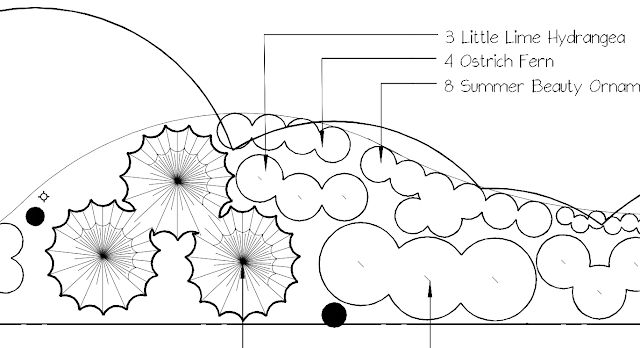Shade Evergreen And Hydrangea Layer Exploration - March 2022
Yesterday, I walked through an exploration of an area in one of my beds that calls for a mix of Tardiva Hydrangea and (now) an upright evergreen layer. That requires the moving/transplanting of four Lilac shrubs that have never taken off due to shade. My #1 backyard priority for 2022 is a focus on shrubs and being deliberate about buying and planting them - versus say...perennial flowers. I've talked about buying and adding a series of Arrowwood Viburnum shrubs in various spots, but there's a segment of our landscape plan that is directly adjacent to yesterday's Lilac replacement area that calls for a mix of hydrangeas and evergreens.
Might there be a solution that accomplishes what the plan calls for (evergreen layer, fronted by hydrangea), uses some of the intel from yesterday's post (potentially using upright Yews or Green Giant Thujas in shade) AND....leave the opportunity for this path to exist in the future? I think so. Here's where my current head is in the annotated image below:
Leaving the (orange upright oval) flowering cherry tree and (for now) the (green circle) sedges, but planting three (or...maybe two) evergreen trees along the fence in purple. And, maybe moving the third over on the *other* side of the path (in blue) to be out near the edge of the bed. That potential evergreen is in the red oval on the right. For these evergreens, I suppose the RIGHT answer is, indeed Canadian Hemlocks. We currently have THREE Hemlock trees planted, but they're TINY and expensive. Putting three larger species here is option 1. Option two? If I use upright Yews in the Tardiva/Lilac area, try Green Giant Thujas here. Option three? If I use Green Giant Thujas by the Lilacs/Tardiva area, use upright Yews here.
Here's a look (below) at this 18-20' area that is bound on one side by the Kwanzan Flowering Cherry tree and on the other by a large (2nd largest on our property) Northern Red Oak tree. You can see the tree here in this post showing some winter/snow damage. That Oak is on the right. In Yellow is a run of various hostas. Green = Everillo Sedges. Orange = Flowering Cherry Tree. This spot, unlike others, does have a lot of blank space.
What is called for in that area? See below for the plan. Three Canadian Hemlocks fronted with three Little Lime Hydrangeas. The Hemlocks are the large trees below:
Importantly, this is a place in the plan that we've begun to think about deviating from - specifically related to a 'path' to the fire pit. See this post for details. And, below, is an annotated photo showing that potential path in blue that wraps right around that Oak tree and runs where the two left-most Hemlocks in the plan would exist:
Will I build the path? I'm not sure. But, I *do* know that if I plant a TREE in the middle of the potential path, we'll NEVER build it. Thus, it feels like I need to leave that option open.
In *front* of this evergreen layer is a trio of Little Lime Hydrangeas. What are Little Limes? They're dwarf versions of Limelight. From Monrovia:
A new dwarf form of the popular Limelight Hydrangea, Little Lime sports the same great flower power but in a smaller package. Attractive green summer flowers turn pink in fall. This hardy selection is excellent for use in mixed border or foundation plantings.
It is the product of an open pollination in a planned breeding program that took place in Grand Haven, Michigan in August of 2005 between Hydrangea paniculata 'Limelight Variegated' (female parent) and an unknown selection of Hydrangea paniculata (male parent).
I like the idea of using a dwarf here - space constraints and all - so this makes sense to me. I have a pair of dwarf (Munchkin) Oakleaf Hydrangeas already, so adding these Little Lime would be my second step into the dwarf hydrangea world.
Just like yesterday's post about the Lilac area, this exploration seems to have shaped my thinking and shopping list.
Across the two areas, I need six upright evergreens. Combination of Yews, Hemlocks and Thujas. And three Tardiva hydrangeas and three Little Lime Hydrangeas.


.png)




Comments
Post a Comment
Be nice to each other here.